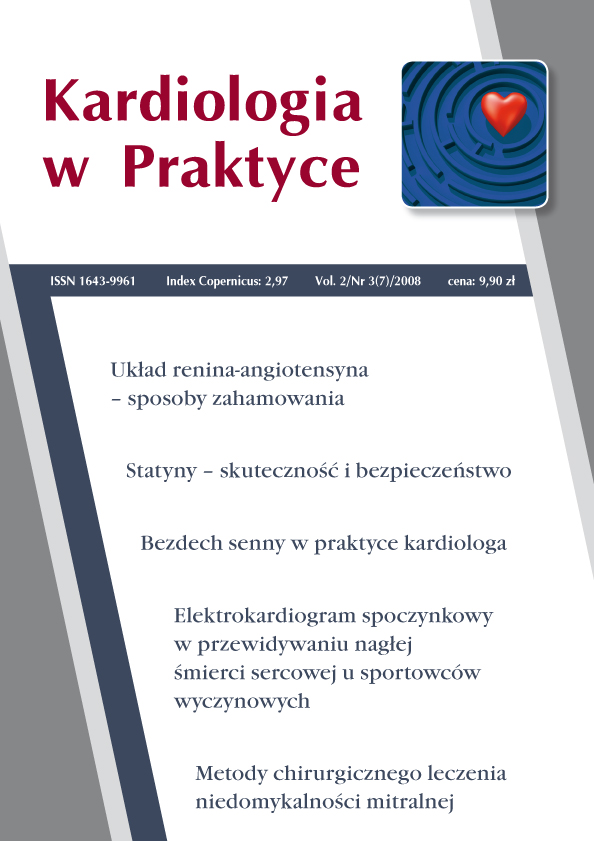Układ renina-angiotensyna – sposoby zahamowania Artykuł przeglądowy
##plugins.themes.bootstrap3.article.main##
Abstrakt
Układ renina-angiotensyna odgrywa zasadniczą rolę w regulacji funkcji i struktury układu krążenia. Jego nadmierna aktywacja może być związana z rozwojem powikłań sercowo-naczyniowych. Obecnie wiele leków pozwala zahamować układ renina-angiotensyna na różnych etapach jego aktywacji. Najczęściej stosowane są inhibitory konwertazy oraz antagoniści receptora dla angiotensyny. Liczne badania wskazują na podobną skuteczność obu grup leków w redukcji ciśnienia tętniczego i zmniejszaniu ryzyka sercowo-naczyniowego. Dowodzą tego wyniki badania ONTARGET, bezpośrednio porównującego inhibitor konwertazy i sartan w grupie chorych wysokiego ryzyka. Łączne stosowanie omawianych grup leków jest mniej uzasadnione. Badania wskazują na korzyści z jednoczesnego stosowania tych leków u chorych z niewydolnością serca lub nefropatią. W badaniu ONTARGET stosowanie inhibitora ACE i sartanu nie przynosiło większych korzyści niż podawanie leków osobno, na dodatek wiązało się z częstszymi działaniami niepożądanymi oraz częstszym występowaniem niewydolności nerek.
Pobrania
##plugins.themes.bootstrap3.article.details##

Utwór dostępny jest na licencji Creative Commons Uznanie autorstwa – Użycie niekomercyjne – Bez utworów zależnych 4.0 Międzynarodowe.
Copyright: © Medical Education sp. z o.o. This is an Open Access article distributed under the terms of the Attribution-NonCommercial 4.0 International (CC BY-NC 4.0). License (https://creativecommons.org/licenses/by-nc/4.0/), allowing third parties to copy and redistribute the material in any medium or format and to remix, transform, and build upon the material, provided the original work is properly cited and states its license.
Address reprint requests to: Medical Education, Marcin Kuźma (marcin.kuzma@mededu.pl)
Bibliografia
2. Dzau V.J.: Circulating versus local renin-angiotensin system in cardiovascular homeostasis. Circulation 1988, 77: 1-3.
3. Dzau V.J., Sasamura H., Hein L.: Heterogeneity of angiotensin synthetic pathways and receptor subtypes: physiological and pharmacological implications. J. Hypertens. 1993, 11(supl.): S13-18.
4. Timmermans P.B., Smith R.D.: Angiotensin II receptor subtypes: selective antagonists and functional correlates. Eur. Heart J. 1994, 15(supl. D): 79-87.
5. Paul M., Mehr A.P., Kreutz R.: Physiology of local renin-angiotensin systems. Physiol. Rev. 2006, 86: 747-803.
6. Boehm M., Abel E.: Angiotensin- converting enzyme 2 – a new cardiac regulator. N. Engl. J. Med. 2002, 347(22): 1795-1797.
7. Chappell M.C.: Emerging evidence for a functional angiotensin-converting enzyme 2-angiotensin-(1-7)-Mas receptor axis: more than regulation of blood pressure? Hypertension 2007, 50: 596-599.
8. Azizi M., Webb R., Nussberger J., Hollenberg N.K.: Renin inhibition with aliskiren: where are we now, and where are we going? J. Hypertens. 2006, 24: 243-256.
9. Gradman A.H., Schmieder R.E., Lins R.L. et al.: Aliskiren, a novel orally effective renin inhibitor, provides dosedependent antihypertensive efficacy and placebo-like tolerability in hypertensive patients. Circulation 2005, 111: 1012-1018.
10. Bicket D.P.: Using ACE Inhibitors Appropriately. Am. Fam. Physician 2002, 66: 461-468.
11. Lopez-Sendon J., Swedberg K., McMurray J. et al.: Expert consensus document on angiotensin converting enzyme inhibitors in cardiovascular disease. The Task Force on ACE-inhibitors of the European Society of Cardiology. Eur. Heart J. 2004, 25: 1454-1470.
12. The Heart Outcomes Prevention Evaluation (HOPE) Study Investigators: Effects of an angiotensin-converting-enzyme inhibitor, ramipril, on cardiovascular events in high-risk patients. N. Engl. J. Med. 2000, 342: 145-153.
13. The Task Force for the Management of Arterial Hypertension of the European Society of Hypertension and of the European Society of Cardiology: 2007 Guidelines for the Management of Arterial Hypertension. J. Hypertens. 2007, 25: 1105-1187.
14. Diagnostyka i leczenie przewlekłej niewydolności serca Wytyczne postępowania Europejskiego Towarzystwa Kardiologicznego (European Society of Cardiology – ESC). Uaktualnienie 2005. Kardiologia Polska 2005, 63(5): 509-543.
15. Barnett A.H., Bain S.C., Bouter P. et al. (for the Diabetics Exposed to Telmisartan and Enalapril Study Group): Angiotensin-Receptor Blockade versus Converting–Enzyme Inhibition in Type 2 Diabetes and Nephropathy. N. Engl. J. Med. 2004, 351: 1952-61.
16. Parving H., Lehnert H., Brochner-Mortensen J. et al.: Irbesartan in Patients with Type 2 Diabetes and Microalbuminuria Study Group. The effect of irbesartan on the development of diabetic nephropathy in patients with type 2 diabetes. N. Engl. J. Med. 2001, 345: 870-878.
17. Pitt B., Remme W., Zannad F. et al.: Eplerenone, a selective aldosterone blocker, in patients with left ventricular dysfunction after myocardial infarction. N. Engl. J. Med. 2003, 348: 1309-21.
18. The ONTARGET Investigators: Telmisartan, Ramipril, or Both in Patients at High Risk for Vascular Events. N. Engl. J. Med. 2008, 358: 1547- 1559.
19. Nakao N., Yoshimura A., Morita H. et al.: Combination treatment of angiotensin-II receptor blocker and angiotensin-converting-enzyme inhibitor in non-diabetic renal disease (COOPERATE): a randomised controlled trial. Lancet 2003, 361: 117-124.
20. Mogensen C.E., Neldam S., Tikkanen I. et al.: Randomised controlled trial of dual blockade of renin-angiotensin system in patients with hypertension, microalbuminuria, and non-insulin dependent diabetes: the candesartan and lisinopril microalbuminuria (CALM) study. BMJ 2000, 321: 1440-1444.
21. Struckman D.R., Rivey M.P.: Combined therapy with an angiotensin II receptor blocker and an angiotensin-converting enzyme inhibitor in heart failure. Ann. Pharmacother. 2001, 35: 242-248.
22. Cohn J.C., Tognoni G.T. (for the Valsartan heart failure trial investigators): A randomized trial of the angiotensin-receptor blocker valsartan in chronic heart failure. N. Engl. J. Med. 2001, 345: 1667-75.
